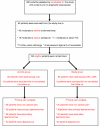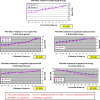The efficacy of laparoscopic uterosacral nerve ablation (LUNA) in the treatment of unexplained chronic pelvic pain: a randomized controlled trial
- PMID: 21461043
- PMCID: PMC3041907
- DOI: 10.1007/s10397-010-0612-1
The efficacy of laparoscopic uterosacral nerve ablation (LUNA) in the treatment of unexplained chronic pelvic pain: a randomized controlled trial
Abstract
The aim of this work is to explore the efficacy , safety, and patients' satisfaction of laparoscopic uterosacral nerve ablation (LUNA) in relief of pain in women with chronic pelvic pain in whom diagnostic laparoscopy reveals either no pathology or mild endometriosis (AFS score ≤5). The study was a prospective, single-blind, randomized trial with 12 months follow-up. It was conducted at the endoscopy unit of the Gynecology Department of El Minia University Hospital, Egypt. One hundred ninety Egyptian women consented to participate in the study. These eligible patients were randomized using computer-generated tables and were divided into two equal groups, including the control group (diagnostic laparoscopy with no pelvic denervation) and the study group (diagnostic laparoscopy plus LUNA). Diagnostic laparoscopy with or without laparoscopic uterosacral nerve ablation was done. There were no statistically significant difference between both groups regarding the efficacy and the overall success rate (between group I and group II, it was 77.64%, 76.47%, and 74.11% versus 79.06%, 75.58%, and 73.25% at 3, 6, and 12 months, respectively) and the cumulative patients' satisfaction rate (it was 74.11%, 74.11%, and 71.76% versus 75.58%, 75.58%, and 72.09% at 3, 6, and 12 months between group I and group II, respectively; P ≤ 0.05). There was no statistically significant difference between both groups as regards the effectiveness of LUNA in the treatment of primary (spasmodic) and secondary (congestive) dysmenorrhea (P ≤ 0.05), while there was a statistically significant difference between both groups in the treatment of dyspareunia (P ≥ 0.05). LUNA can be a last alternative option in well-selected patients for control of chronic pelvic pain without endometriosis; however, its effectiveness may not extend to other indications. Also, preliminary experience in the treatment of primary deep dyspareunia presents a promising perspective on the management of deep dyspareunia, especially if it will involve a team of social, psychological, and gynecological specialists.
Figures
Similar articles
-
A randomised controlled trial to assess the efficacy of Laparoscopic Uterosacral Nerve Ablation (LUNA) in the treatment of chronic pelvic pain: The trial protocol [ISRCTN41196151].BMC Womens Health. 2003 Dec 8;3(1):6. doi: 10.1186/1472-6874-3-6. BMC Womens Health. 2003. PMID: 14662012 Free PMC article.
-
Laparoscopic uterosacral nerve ablation for alleviating chronic pelvic pain: a randomized controlled trial.JAMA. 2009 Sep 2;302(9):955-61. doi: 10.1001/jama.2009.1268. JAMA. 2009. PMID: 19724042 Clinical Trial.
-
A double-blind randomised controlled trial of laparoscopic uterine nerve ablation for women with chronic pelvic pain.BJOG. 2004 Sep;111(9):950-9. doi: 10.1111/j.1471-0528.2004.00233.x. BJOG. 2004. PMID: 15327610 Clinical Trial.
-
Meta-analysis using individual patient data from randomised trials to assess the effectiveness of laparoscopic uterosacral nerve ablation in the treatment of chronic pelvic pain: a proposed protocol.BJOG. 2007 Dec;114(12):1580, e1-7. doi: 10.1111/j.1471-0528.2007.01542.x. BJOG. 2007. PMID: 17995500 Review.
-
Pelvic denervation procedures for dysmenorrhea.Curr Opin Obstet Gynecol. 2017 Aug;29(4):225-230. doi: 10.1097/GCO.0000000000000379. Curr Opin Obstet Gynecol. 2017. PMID: 28683027 Review.
Cited by
-
Surgical interventions for the management of chronic pelvic pain in women.Cochrane Database Syst Rev. 2021 Dec 20;12(12):CD008212. doi: 10.1002/14651858.CD008212.pub2. Cochrane Database Syst Rev. 2021. PMID: 34923620 Free PMC article.
-
Chronic pelvic pain in endometriosis: an overview.J Clin Med Res. 2013 Jun;5(3):153-63. doi: 10.4021/jocmr1288w. Epub 2013 Apr 23. J Clin Med Res. 2013. PMID: 23671540 Free PMC article.
References
LinkOut - more resources
Full Text Sources


